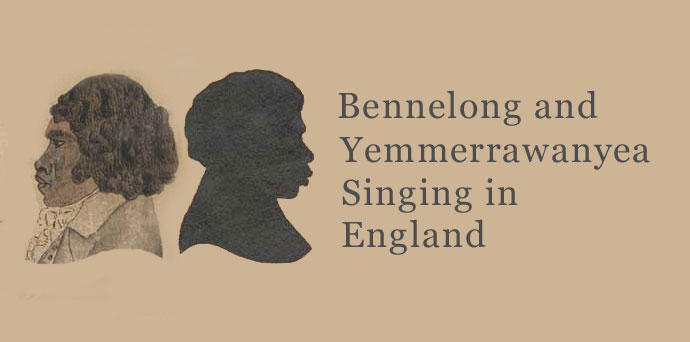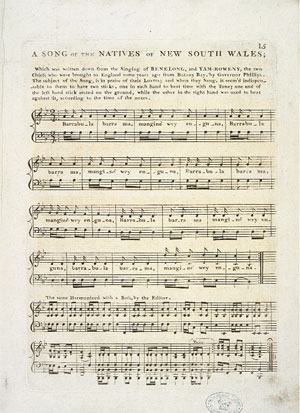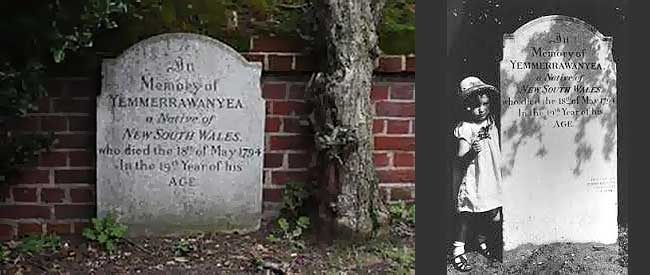Bennelong and Yemmerrawanyea singing in England
AUDIO: Bennelong and Yemmerawanne's song, performed in London in 1792, as notated and published by musician Edward Jones in 1811. This version is performed by Clarence Slockee and Matthew Doyle at the State Library of NSW, August 2010 (an image of Clarence and Matthew further down the page).

Left: Banalong [Bennelong] c1793 William Waterhouse (State Library of NSW)
Right:Yuremany [Yemmerrawanne] (State Library of NSW) This silhouette image is the only known picture of him.
Voices and songs across the centuries
The name Bennelong is etched into the minds of most people in 'Australia' - but few know of the Aboriginal man Yemmerrawanyea, who traveled to England and lived with him there until his death.
(ABC RN 'Hindsight' program)
Keith Vincent Smith made some extraordinary discoveries about Bennelong and Yemmerrawanyea, but Yemmerrawanyea is left out of the story by the media and writers.
Smith uncovered a song these two men sang for the English hosts in 1793. You'll hear a rendition of the song recently performed in the audio.
In 2011 a physical geographer located the site of Bennelong's grave, under a street in suburban Sydney. It's been 'lost' for almost two hundred years, whereas the general grave-site location of Yemmerrawanyea is known and a headstone still exists within the vicinity.
Some of Bennelong's letters are also read on this audio (above). giving us a glimpse of him speaking to us across the centuries, in words and song.
1793: A Song of the Natives of New South Wales
Keith Vincent Smith

Click to enlarge
'A Song of the Natives of New South Wales'.
Edward Jones, Musical Curiosities(sic)
(British Library, R.M. 13.f.5, f. 15.).
(British Library)
In a townhouse in London's Mayfair, near Berkeley Square, two Aboriginal men sing in their own language 'in praise of their lovers'. Their voices rise above the repetitive beat of the two hardwood sticks they clap together to maintain the rhythm.
They wear fashionable Regency breeches, buckled shoes, ruffled shirts and waistcoats.
The year is 1793 and the singers are Bennelong and Yemmerrawanne, far from their Wangal homeland on the south bank of the Parramatta River in Sydney. This was certainly the first time an Aboriginal song was performed in Europe ...
The words and music were written down by Edward Jones (1752-1824), the Welsh harpist, composer, folk music collector and bard to the Prince of Wales (later George IV), who published ‘A song of the natives of New South Wales’ in Musical Curiosities (London, 1811), a work of 40 folio sheets.
Woollarawarre Bennelong (c. 1764-1813) and Colebee (c. 1770-1806), leader of the Cadigal, a clan inhabiting the eastern side of Port Jackson (Sydney Harbour), were captured on 25 November 1789 on the orders of Captain Arthur Phillip, first governor of the convict colony established at Sydney in January 1788. Colebee soon escaped, but Bennelong formed an unlikely friendship with Phillip and ‘came in’ peacefully to Sydney Town with his people in September 1790 ...
Yemmerrawanyea
Yemmerrawanyea was known by various spellings: Yuremany, Yemmerrawanne, Yemmorravonyea, Yemmerrawanie, Yemmeraiwanya, Yemmerewanyea, Imeerawanyee, and Immirawanya. Yemmerrawanyea was the spelling on his headstone.
Yemmerrawanne was well-known to the British settlers; he was described by Captain Watkin Tench as a "good-tempered lively lad" who became "a great favourite with us, and almost constantly lived at the governor's house". Clothes were made for him, and he learnt to wait on the table.

(portrait by Jon Lewis 'cropped' www.jonnylewis.org)
In February 1791, aged about 16, Yemmerrawanne was initiated, as was the Aboriginal custom, by having a front tooth knocked out.
In December 1792, Arthur Phillip left the colony on the convict transport ship Atlantic to return to England. Yemmerrawanne and Bennelong went with Phillip "voluntarily and cheerfully", knowing that their destination was "at a great distance". They arrived at Falmouth, Cornwall in May 1793.
After arriving in London, Yemmerrawanne and Bennelong were provided with fashionable clothing, suitable for wearing in English society. They stayed in Mayfair at the home of William Waterhouse, father of Henry Waterhouse, and visited a variety of shows and other entertainments in London. Tutors were hired to educate them in reading, writing and the English language.
While in Mayfair, Yemmerrawanne and Bennelong gave a recital of a native song accompanied by clapsticks. One of their audience, Edward Jones wrote down and published the words and music (in Musical Curiosities, London, 1811), the oldest known published music from the island continent named 'Australia' by the colonisers.
In September 1793, Yemmerrawanne was ill and reportedly appeared "much emaciated". The following month he injured his leg, and his health continued to deteriorate. Both Aborigines were moved to Eltham, where Yemmerrawanne was treated by the physician Gilbert Blane. His illness persisted, despite a variety of treatments, and Yemmerrawanne died on 18 May 1794, aged about 19, from a lung infection. He was buried in the local churchyard.
There have been several campaigns, including plans by Burnum Burnum and Geoffrey Robertson, to return Yemmerrawanne's remains to 'Australia', but the current location of his remains is unknown. The gravestone's location is known, but it has been moved several times since his burial.

Right: The headstone at it's original location (image date not known).
Yemmerrawanyea's headstone has been restored several times over the last couple of hundred years, now located against the boundary wall separating the churchyard from Eltham High Street (on the southern side of the church).
Three Aboriginal men, Michael Bungapidju and Murphy Dhulparippa from Yirrkala in the Gove Peninsula, Arnhem Land, and Ralph Nichols from Melbourne, made a pilgrimage to the grave of 'Yemmerawanyea' at Eltham in March 1982 but were not aware that his body had been removed. They are generally believed to be the first Australian Aboriginal people to visit the grave of Yemmerrawanyea in Eltham Churchyard.
The late Harry Penrith, the Aboriginal activist, actor and writer better known as Burnum Burnum, who saw the headstone in January 1988 also hoped to retrieve Yemmerrawanne's remains and return them to Australia.

